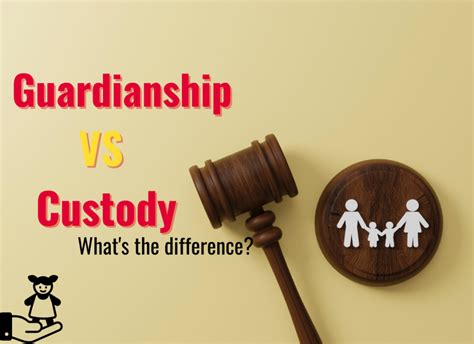In the realm of child welfare, the terms “guardianship” and “custody” often arise, bringing about confusion and misconceptions. While they may sound similar, these legal concepts possess distinct meanings and implications. This article delves into the intricate differences between guardianship and custody, highlighting their key aspects, legal ramifications, and practical implications.

Guardianship
Definition: Guardianship entails the legal transfer of authority and responsibility for a child to an individual or entity other than their biological parents. This arrangement typically occurs when the parents are deemed incapable or unwilling to provide adequate care for their child.
Types of Guardianship:
- Temporary guardianship: Short-term guardianship, usually lasting for a specific period, granted in emergency situations or when the parents are temporarily unable to care for the child.
- Permanent guardianship: Long-term or indefinite guardianship, granted when the parents’ inability or unwillingness to provide care is likely to continue for an extended period.
Rights and Responsibilities:
Guardians are legally responsible for the child’s upbringing, including making decisions regarding their health, education, residence, and overall well-being. They have the same rights and responsibilities as the child’s parents.
Custody
Definition: Custody refers to the legal right to have physical care and control of a child. It involves the responsibilities of providing the child with a home, shelter, food, clothing, education, and healthcare.
Types of Custody:
- Sole custody: One parent has exclusive authority to make all decisions regarding the child’s care and upbringing.
- Joint custody: Both parents share decision-making responsibilities for the child, including education, healthcare, and extracurricular activities.
- Split custody: One parent has physical custody of the child while the other has legal custody, making decisions regarding the child’s education, healthcare, and religion.
Rights and Responsibilities:
Custodial parents have the right to determine the child’s daily routines, residence, and activities. They are responsible for providing a stable and nurturing environment for the child.
Key Differences Between Guardianship and Custody
While guardianship and custody both involve the care of children, they exhibit fundamental distinctions:
- Legal Authority: Guardians have legal authority to make all decisions regarding the child’s upbringing, while custodial parents have authority only over the child’s physical care.
- Duration: Guardianship is usually long-term or indefinite, while custody can be temporary or permanent.
- Focus: Guardianship primarily addresses the child’s welfare and future, while custody focuses on the present needs of the child.
- Termination: Guardianship can be terminated if the parents regain their capacity to care for the child or if the child reaches the age of majority. Custody, on the other hand, typically continues until the child reaches the age of majority.
Pain Points and Motivations
Pain Points:
- Unclear legal distinctions between guardianship and custody.
- Lengthy and costly legal processes to establish guardianship or custody.
- Difficulty in balancing the child’s best interests with the rights of parents.
Motivations:
- Ensuring the well-being of children whose parents are unable or unwilling to provide adequate care.
- Maintaining continuity and stability in a child’s life after a parental crisis.
- Protecting children from harm or neglect.
Effective Strategies
Strategies for Establishing Guardianship:
- Contact a family law attorney to initiate the legal process.
- Gather evidence of the child’s need for guardianship.
- Establish a stable and responsible living environment for the child.
Strategies for Establishing Custody:
- File a petition with the family court.
- Present evidence of your ability to provide a safe and nurturing environment for the child.
- Negotiate a custody agreement with the other parent, if possible.
Frequently Asked Questions
1. Can a guardian adopt the child under their care?
In some cases, yes. If the parents’ parental rights are terminated, the guardian may be able to adopt the child.
2. Can custodial parents make major decisions for the child?
Yes, custodial parents retain the right to make major decisions regarding the child’s education, healthcare, and religious upbringing.
3. What happens if the guardian or custodial parent becomes ill or dies?
In the event of the guardian’s or custodial parent’s incapacity or death, a new guardian or custodian will need to be appointed by the court.
4. Can a parent regain custody after it has been granted to another party?
Yes, it is possible for a parent to regain custody if they can show that they have changed their circumstances and are now fit to provide a stable and nurturing environment for the child.
5. What is the difference between legal custody and physical custody?
Legal custody refers to the decision-making authority over the child, while physical custody refers to the responsibility for the child’s daily care and supervision.
6. What is a “best interests of the child” analysis?
Courts conduct a “best interests of the child” analysis when determining custody or guardianship arrangements. This analysis considers factors such as the child’s safety, emotional well-being, and educational needs.
7. What is the role of a guardian ad litem?
A guardian ad litem is an attorney appointed by the court to represent the child’s best interests in custody and guardianship proceedings.
8. Can a grandparent obtain guardianship of their grandchild?
Yes, in some states, grandparents may have standing to seek guardianship of their grandchildren if the parents are deemed unfit.
Conclusion
Guardianship and custody are essential legal concepts that aim to protect the well-being of children in situations where their parents are unable or unwilling to provide adequate care. Understanding the key differences between these arrangements is crucial for making informed decisions about the best course of action in the best interests of the child. By navigating the legal complexities and seeking appropriate legal guidance, individuals can ensure the stability and well-being of children in need.
